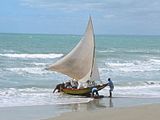
Roanoke Island is an island in Dare County, bordered by the Outer Banks of North Carolina. It was named after the historical Roanoke, a Carolina Algonquian people who inhabited the area in the 16th century at the time of English colonization.

Dare County is the easternmost county in the U.S. state of North Carolina. As of the 2020 census, the population was 36,915. Its county seat is Manteo.

Manteo is a town in Dare County, North Carolina, United States, located on Roanoke Island. The population was 1,602 at the 2020 census. It is the county seat of Dare County.

CSS Albemarle was a steam-powered casemate ironclad ram of the Confederate Navy, named for an estuary in North Carolina which was named for General George Monck, the first Duke of Albemarle and one of the original Carolina Lords Proprietor.
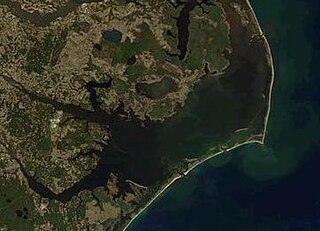
Pamlico Sound is a large estuarine lagoon in North Carolina. The largest lagoon along the North American East Coast, it extends 80 mi (130 km) long and 15 to 20 miles wide. It is part of a large, interconnected network of similar lagoons that includes Albemarle Sound, Currituck Sound, Croatan Sound, Roanoke Sound, Pamlico Sound, Bogue Sound, Back Sound, and Core Sound known collectively as the Albemarle-Pamlico sound system. With over 3,000 sq. mi. (7,800 km2) of open water the combined estuary is second only in size to 4,479 sq mi (11,600 km2) Chesapeake Bay in the United States.
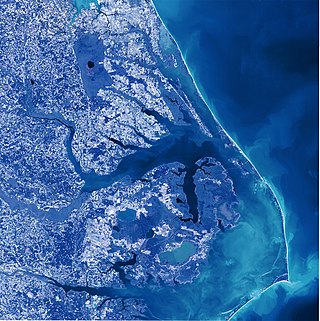
Albemarle Sound is a large estuary on the coast of North Carolina in the United States located at the confluence of a group of rivers, including the Chowan and Roanoke. It is separated from the Atlantic Ocean by the Currituck Banks, a barrier peninsula upon which the town of Kitty Hawk is located, at the eastern edge of the sound, and part of the greater Outer Banks region. Roanoke Island is situated at the southeastern corner of the sound, where it connects to Pamlico Sound. Much of the water in the Albemarle Sound is brackish or fresh, as opposed to the saltwater of the ocean, as a result of river water pouring into the sound.

The Roanoke River runs 410 miles (660 km) long through southern Virginia and northeastern North Carolina in the United States. A major river of the southeastern United States, it drains a largely rural area of the coastal plain from the eastern edge of the Appalachian Mountains southeast across the Piedmont to Albemarle Sound. An important river throughout the history of the United States, it was the site of early settlement in the Virginia Colony and the Carolina Colony. An 81-mile (130 km) section of its lower course in Virginia between the Leesville Lake and Kerr Lake is known as the Staunton River, pronounced, as is the Shenandoah Valley city of that name. It is impounded along much of its middle course to form a chain of reservoirs.

The American shad is a species of anadromous clupeid fish naturally distributed on the North American coast of the North Atlantic, from Newfoundland to Florida, and as an introduced species on the North Pacific coast. The American shad is not closely related to the other North American shads. Rather, it seems to form a lineage that diverged from a common ancestor of the European taxa before these diversified.
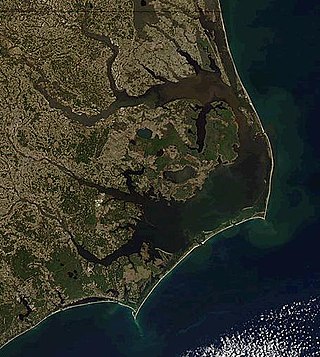
The Outer Banks are a 200 mi (320 km) string of barrier islands and spits off the coast of North Carolina and southeastern Virginia, on the east coast of the United States. They line most of the North Carolina coastline, separating Currituck Sound, Albemarle Sound, and Pamlico Sound from the Atlantic Ocean. A major tourist destination, the Outer Banks are known for their wide expanse of open beachfront and Cape Hatteras National Seashore. The seashore and surrounding ecosystem are important biodiversity zones, including beach grasses and shrubland that help maintain the form of the land.

The skipjack is a traditional fishing boat used on the Chesapeake Bay for oyster dredging. It is a sailboat which succeeded the bugeye as the chief oystering boat on the bay, and it remains in service due to laws restricting the use of powerboats in the Maryland state oyster fishery.

The Chowan River (cho-WAHHN) is a blackwater river formed with the merging of Virginia's Blackwater and Nottoway rivers near the state line between Virginia and North Carolina. According to the USGS a variant name is Choan River.

Roanoke Island Festival Park is a North Carolina state historic site located at the end of NC 400 in Manteo, North Carolina on Roanoke Island. The park includes a recreated 16th-century sailing ship, living history demonstrators, a museum, and a variety of performing and visual arts. Admission includes the main attractions and is valid for two days.

Lake Gaston is a reservoir in the eastern United States. Part of the lake is in the North Carolina counties of Halifax, Northampton, and Warren. The part extending into Virginia lies in Brunswick and Mecklenburg counties. Lake Gaston is roughly 35 miles (56 km) long and covers over 20,000 acres (81 km2), with 350 miles (560 km) of shoreline.
The hickory shad, fall herring, mattowacca, freshwater taylor or bonejack is a member of the family Alosidae, ranging along the East Coast of the United States from Florida to the Gulf of Maine. It is an anadromous fish species, meaning that it spawns in freshwater portions of rivers, but spends most of its life at sea. It is subject to fishing, both historic and current, but it is often confused with or simply grouped together with American shad in catch statistics.
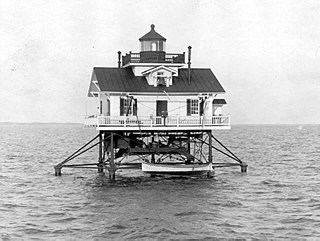
Roanoke Marshes Light was a screw-pile lighthouse in North Carolina, United States.

Shad is a type of fish, much valued as a sport fish. The male shad is an excellent game fish, showing multiple jumps and an occasional end-over-end; it has been called a "freshwater tarpon". The gravid female does not fight much, but is often kept for the roe. The current world record is listed by the IGFA as 11 pounds 4 ounces (5.1 kg), set at Holyoke Dam, Massachusetts, on 19 May 1986 by Robert A. Thibodo.

The Roanoke River Lighthouse is a historic, decommissioned lighthouse, located on the waterfront of Edenton, North Carolina. The lighthouse once stood in Albemarle Sound at the mouth of the Roanoke River, across the Sound from its current location. The only surviving screw-pile lighthouse in the state, it has since been moved twice, and a replica of a predecessor light has been erected at a fourth location.
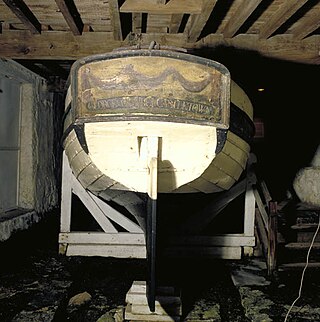
Peggy is an armed yacht built in June 1789 for George Quayle (1751–1835), MHK, a politician and banker on the Isle of Man. She is the oldest surviving Manx craft and is one of only a very few surviving vessels built in the 18th century.

A bracera or brazzera is a traditional Adriatic coastal cargo sailing vessel originated in Dalmatia and first recorded in the 16th-century chronicles. Along with its larger sisters - trabakuls and peligs, braceras formed the backbone of the commercial fleet on the Adriatic Sea with one masted one being the most prominent and best known. This solid and very mobile boat with wide hips and blunt bow was particularly suitable for commerce and communication between the many islands of the Adriatic as well as neighboring coasts. Already in the 19th century over 800 of them were listed in the Austro-Hungarian fleet register covering vessels of the Dalmatian and Istrian coasts. Adriatic braceras distinguish from the vessels carrying same/similar names like, for example, in the Aegean Sea. Unlike there, on the Adriatic the term refers to the entire boat, the system that consists of the hull and the rig as well, and not merely the sail.
The Historic Albemarle Tour or Historic Albemarle Highway is a tour route located in northeastern North Carolina. The tour follows several U.S. and State highways in the seventeen county region, identifying historic sites and towns, marked with brown signs with the George Monck, 1st Duke of Albemarle coat of arms.


















